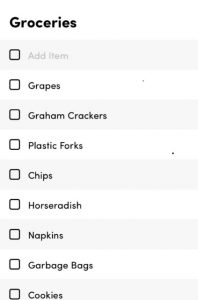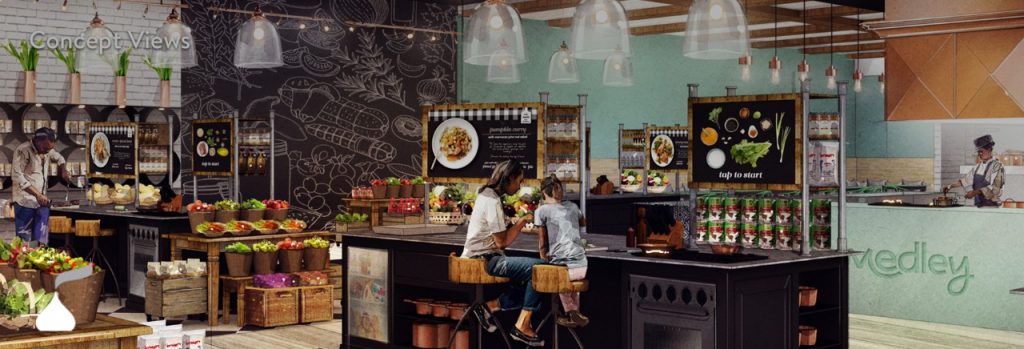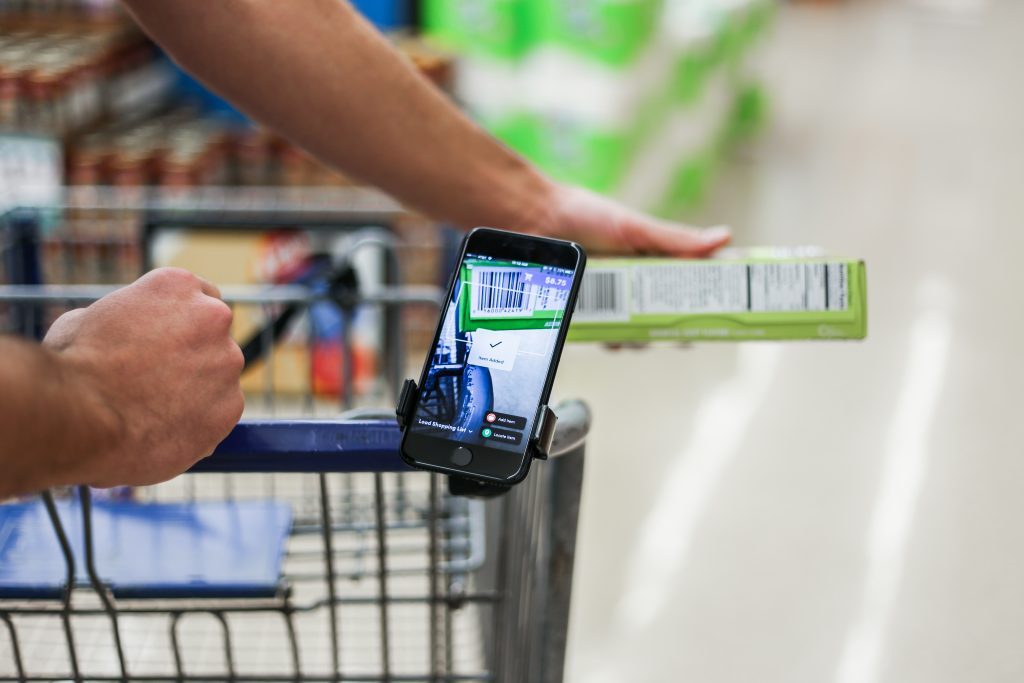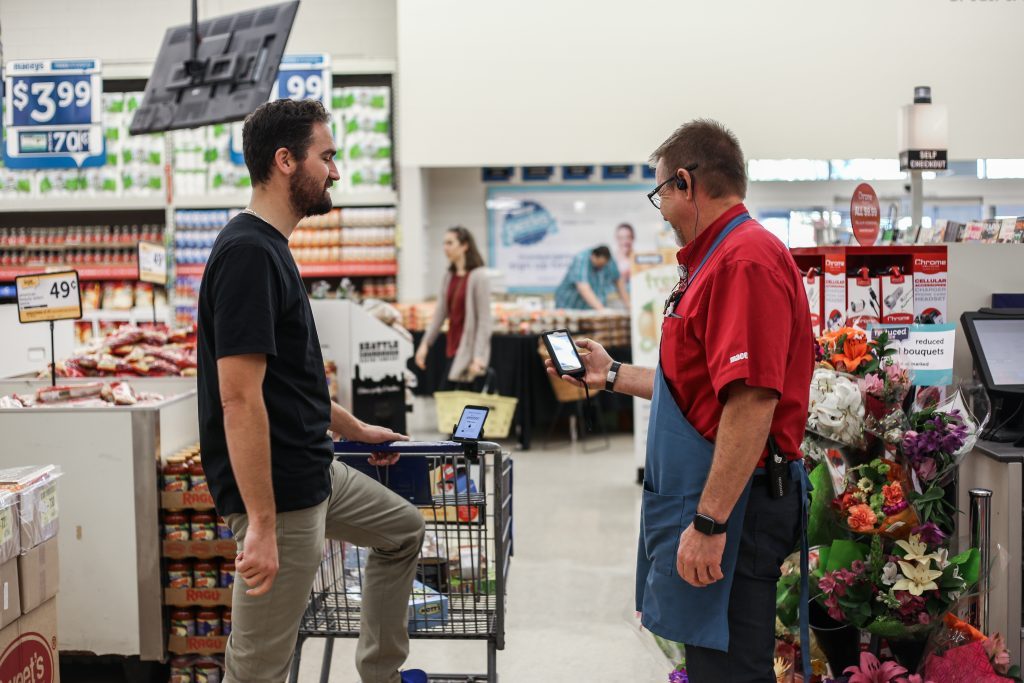In the grocery store 2.0, customers will skip the line, enjoy the wine
Attention, shoppers: This will be fun.
As you enter the store, an app will turn your grocery list into a personalized aisle map. Inside, low shelves will offer a view of the entire market, including friends nibbling seafood in the demo kitchen and neighbors sipping merlot with the wine steward.
In the stockroom, drones will hover, tracking inventory. On the displays, sensors will read your gaze, revealing ingredients in that soup you’re eyeing. When your cart is full, there will be no checkout line to slow your roll.
This is how grocery shopping may look soon at a store near you – more hangout than supermarket, more social club than Sunday chore. While it might seem like a taste of tomorrow, these innovations are reshaping customer experiences today at various stores around the world.

“Shoppers want to shop when they want to shop, how they want to shop and where they want to shop,” said Brian Kavanagh, senior director of retail evolution with the Hershey Company. The confectionery giant has imagined a mock market named “Medley,” a futuristic concept meant to inspire industry leaders to bust free from age-old store designs.
“If you don’t have a fun and engaging grocery experience – if it’s some place people have to go to versus a place they want to go to – you’re going to lose some shoppers,” Kavanagh said. “We’re taking shopping and making it fun again.”
At several grocery chains, shoppers already are sampling digital transformation in the aisles – using smart phones to scan products as they go and accessing mobile checkouts when they’re done. For a glimpse of what’s new and what’s looming, let’s go shopping.
Making a list
A text from a spouse or friend – “Please grab cookies, apples, toothpaste, burgers and dog food” – becomes a sharable, self-organizing list of grocery targets with Skip, an app built on Microsoft Azure for Apple or Android mobile devices.
Customers can download the app to coordinate on a shopping list, said Chase Thomason, founder of the solution.


“They’re building it together,” Thomason said. “And starting later this summer, when you walk into the store with Skip on your phone, we’ll notify whoever you’re collaborating with on that shopping list: ‘Hey, Mike’s at the store, any last-minute items we need?’”
Skip was first deployed last December at Macey’s, a Provo, Utah grocery store. Owned by the retailer cooperative Associated Food Stores (AFS), Macey’s now offers Skip to shoppers at five of its 12 locations in Northern Utah. During the rest of 2017, the app will roll out to customers who shop at more than 100 additional AFS locations, Thomason said.
Aimless wandering and forgetting the soap are issues of the past for Skip users. As shoppers hit the store and open the list in their phones, the app instantly organizes what they need based on where it sits in that store.
When customers grab each item, the app notes a checkmark on the list.
“Before leaving home, maybe you put your granola on the list, and now it may say ‘aisle one.’ Your chips and crackers? ‘Aisle five.’ Chocolate milk, eggs, dairy? ‘Aisle 12.’ Everything is organized by aisle,” Thomason said. “So you know exactly what you’re picking up when you’re in that aisle.
“There’s no going back and forth, no getting lost, no getting home and realizing, ‘Gosh, I forgot the one thing I went to the store to get,” he said. “We try to make it as seamless as possible just to get your stuff done.”
A fresh look
Many stores unintentionally offer a full helping of stale history by surrounding customers with retail artifacts: super-tall shelves, four-wheeled buggies, maze-like layouts and mood music.
“If you think about the experience today in a traditional supermarket, it hasn’t changed that dramatically in the last 40 to 50 years,” said Kavanagh of Hershey. “You’re still pushing a cart down endless aisles, shopping for ingredients.”
Hershey’s conceptual “Medley” store aims to entice grocers to adopt fresh designs and remove those relics. In the “Medley” world, there are no lists, no lines, no carts.

“Medley” staffers would include a butcher who helps with meal planning and a sommelier who pairs wines, beers or spirits. A demo kitchen would allow shoppers to watch chefs cook, and sample their creations. If customers like what they see, hear, smell or taste, they could add those ingredients into a store app, cueing the employees to gather the items and load them into a shopper’s car or deliver them to their home.
“It’s not that farfetched,” Kavanagh said. “Everything that is presented throughout ‘Medley’ could actually open its doors tomorrow. Nothing in there is limited by technology or manpower or products today. It’s about stores saying: ‘If we could start over, with no rules, this is what would we do differently.’‘’
Some of these practices are already in play. Coop Italia, Italy’s largest grocery cooperative, has launched a “supermarket of the future” in Milan. Customers experience grocery 2.0 in the store’s airy layout. The embedded tech brings tomorrow to life.
Motion sensors detect the product a shopper is looking at, opening visual displays of the ingredients, potential allergens and origin of the food, its carbon footprint and suggested wine pairings. Interactive shelves and displays tap data stored on Microsoft Azure using Microsoft SQL server and Microsoft content management capabilities. Cash registers run on an Intel-based platform with Microsoft Windows software.

“The first emotion when (customers) enter the store is ‘wow,’ ” said Gabriele Tubertini, Coop Italia’s chief information officer. “But after the surprise, they understand the purpose of the digital solution and start to dig into the product info using (the displays) to support their decision process.”
Coop Italia debuted the concept at Expo Milan in 2015. The Milan store, which opened last December, has become a laboratory to test the innovative solutions, Tubertini said.
Coop Italia’s forward-looking store is also equipped with a smart inventory system that instantly updates information about what’s on the shelves. This allows market managers to keep goods in a warehouse, rather than on shelves, until items must be replenished.
Stocking up
Fleets of robots and drones are handling that same task for at least a half dozen other stores. Meet Shelfie, a stock-taking device that knows what the “perfect shelf” looks like, thereby alerting store staff when products are out of place, missing or just needing a tweak in the direction they’re facing.
In the aisles, Shelfie’s fixed cameras monitor shelves during store hours. After closing, Shelfie robots journey the aisles to assess what’s on display – and what’s not, said Darren Younger, chief growth officer of Lakeba, an Australian company that developed Shelfie.
Video courtesy of Lakeba.
Status reports are relayed via a dashboard to store managers’ tablets or mobile phones, providing a real-time inventory index running from 0 to 100. Grocery operators can also see how quickly stock is replaced in certain stores. The system uses Microsoft Azure and Power BI.
“So if the Corn Flakes are out of stock, Shelfie tells them,” Younger said. “It tells them where the problem is so they can go and fix it. We want to make sure all the product is displayed at its premium selling position. So everything is front facing, for example.”
In stockrooms and warehouses away from customers, Shelfie drones can work around the clock to gauge inventory availability, reporting that info as well to managers.
“You would see a drone flying around by itself, checking out the stock making sure everything is where it’s supposed to be,” Younger said. “It will go hover in front of a shelf then move to the next shelf.”
Stores in the U.K, Germany, South Africa, Australia and New Zealand are piloting Shelfie robots, Younger said.
Gathering the goods
Many shoppers arrive at the store with a list and a budget. That means, when customers reach the cash register, their anxieties climb as the bill slowly rises. Sometimes, they remove pricier items from their stack when that running tally busts their spending plan.

That’s another pain point the makers of the Skip app intend to soothe. As shoppers work their way through the store, they scan each product with their mobile devices – and see the actual price they’ll pay, including taxes and savings from sales, coupons and loyalty points, said Thomason, the app maker.
“It gives you price transparency,” Thomason said. “You never miss out on a deal. And all those items are accumulated correctly in your cart total.” That’s a huge impact for shoppers, he says, from moms to millennials.
But the app hasn’t merely been hit with younger, tech-laden shoppers at the Macey’s store in Provo, said manager Jeff Rice.
“The younger generation, you see them walking around and the phone never leaves their hand. I thought we would have a huge acceptance in that respect,” said Rice, whose store is located near Brigham Young University. “The funny part is the older generation, like me, really dig it too.”
Checkout time
Across these innovators and grocery operations, there’s a shared vision: unclogging the exit lines by making payments mobile.
At Hershey’s “Medley” store, shoppers would just chill in the café or the wine-tasting area while the staff rounds up their ingredients and shuttles the purchases to their cars. At Coop Italia’s “Supermarket of the Future,” customers can install an app and access a mobile, self-scanning and payment solution, asking that their products be delivered to a dedicated parking spot.
The Skip app addresses that as well.
“As we talked to shoppers more and more about what they want in their experience, and what were the most frustrating points in their experience, the biggest problem they have is waiting in line,” Thomason said.

To alleviate that, Skip’s mobile payment capabilities can be merged with a new checkout stand design. In Provo, the storefront recently was reconfigured – one cashier lane was removed and replaced with a dedicated lane for Skip shoppers. App users head there with full carts of items already purchased. They pause for a 15-second cart review by a store employee, who will bag groceries, if needed.
“This makes it a destination where people will want to come shop,” Rice said. “I’m excited about that.”
Over the next few months, the Transform blog will feature several storylines inspired by companies now making a digital difference. This is the first in the series.
Top image: The conceptual “Medley” store, courtesy of Hershey.








